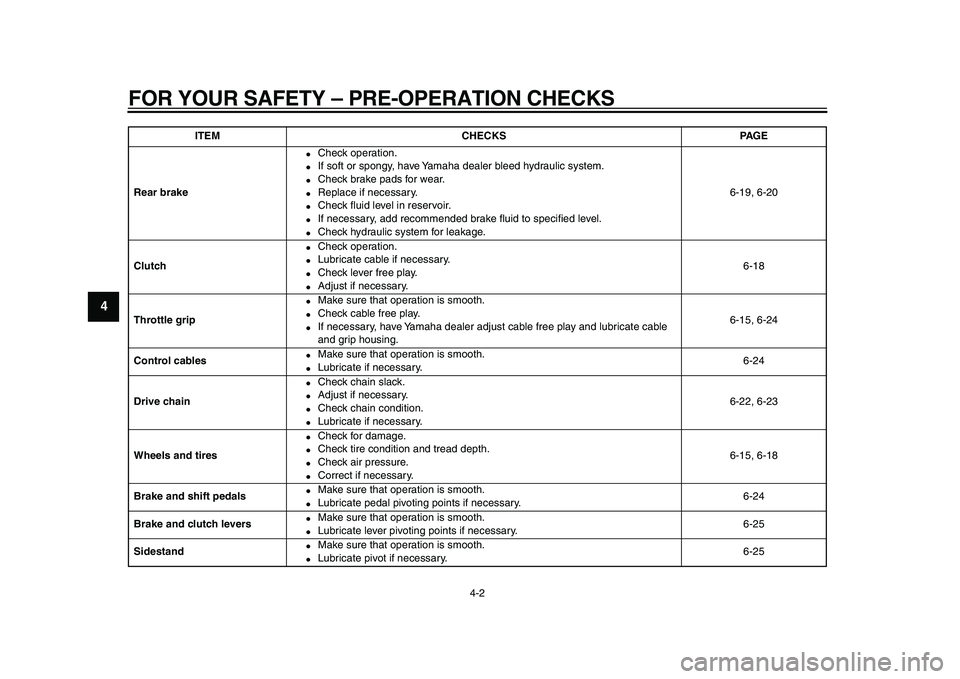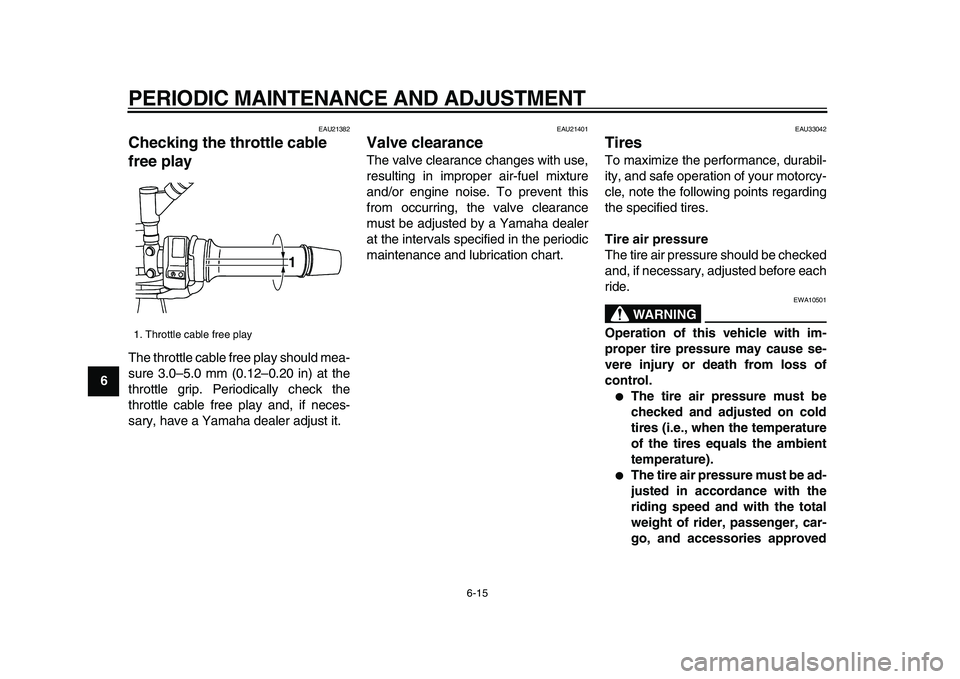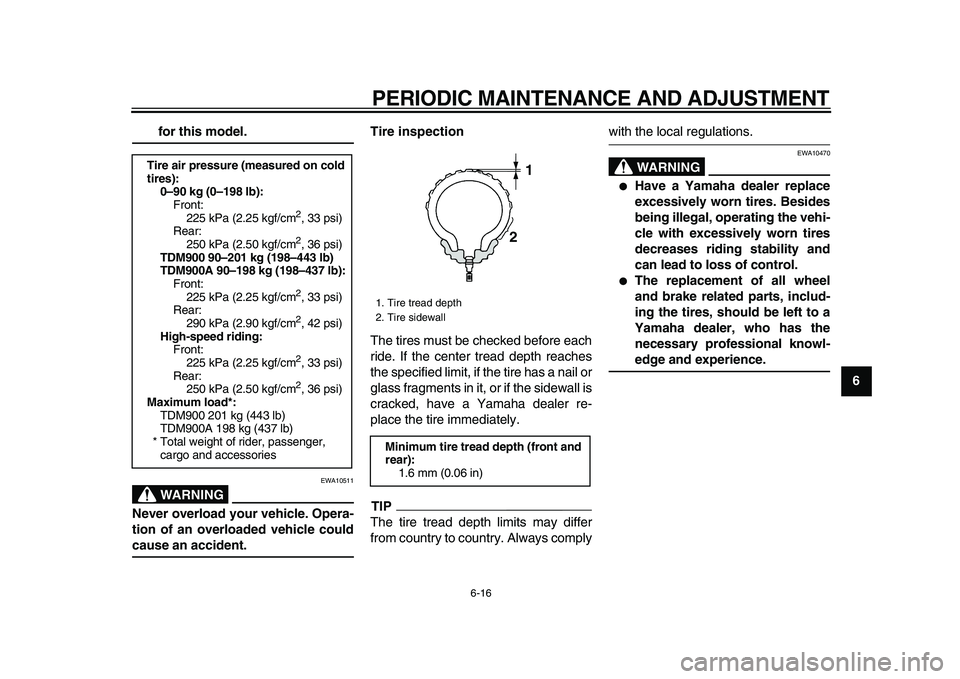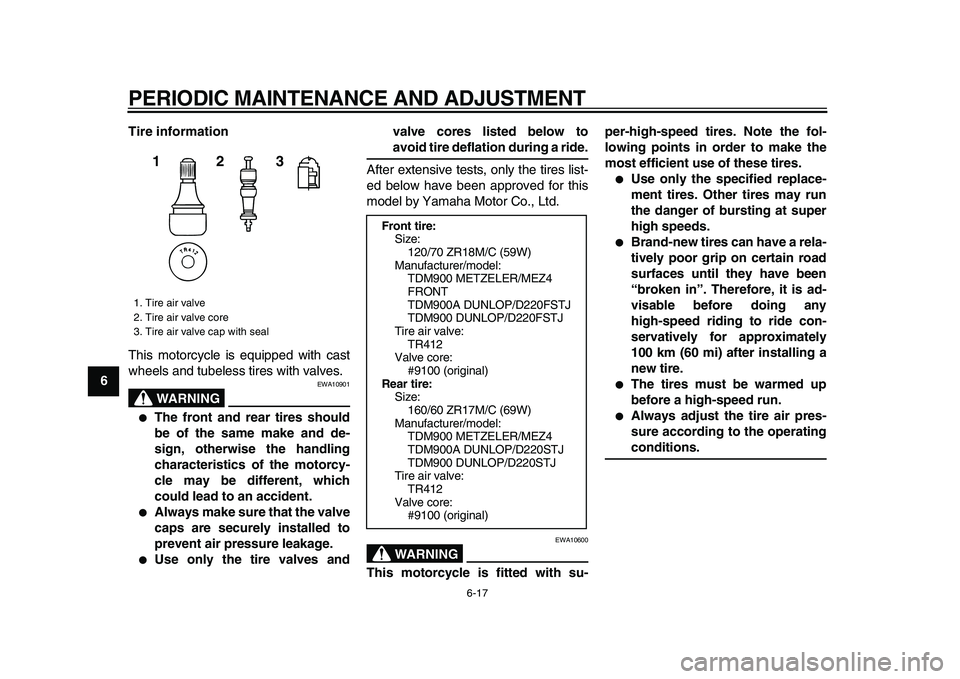2009 YAMAHA TDM 900 tires
[x] Cancel search: tiresPage 6 of 94

TABLE OF CONTENTS
SAFETY INFORMATION
...................1-1
DESCRIPTION
...................................2-1
Left view ...........................................2-1
Right view .........................................2-3
Controls and instruments..................2-5
INSTRUMENT AND CONTROL
FUNCTIONS
........................................3-1
Immobilizer system ..........................3-1
Main switch/steering lock .................3-2
Indicator and warning lights .............3-4
Tachometer unit ...............................3-6
Coolant temperature gauge .............3-7
Multi-function display .......................3-7
Anti-theft alarm (optional) ................3-9
Handlebar switches .........................3-9
Clutch lever ....................................3-10
Shift pedal ......................................3-11
Brake lever ....................................3-11
Brake pedal ...................................3-12
ABS (for ABS models) ...................3-12
Fuel tank cap .................................3-13
Fuel ................................................3-14
Fuel tank breather hose .................3-15
Catalytic converters .......................3-15
Seat ...............................................3-16
Storage compartment ....................3-17
Adjusting the front fork ...................3-17
Adjusting the shock absorber
assembly ....................................3-19Luggage strap holders .................. 3-20
Sidestand ...................................... 3-21
Ignition circuit cut-off system ......... 3-21
FOR YOUR SAFETY –
PRE-OPERATION CHECKS
.............. 4-1
OPERATION AND IMPORTANT
RIDING POINTS
.................................. 5-1
Starting the engine .......................... 5-1
Shifting ............................................ 5-2
Tips for reducing fuel consumption . 5-3
Engine break-in ............................... 5-3
Parking ............................................ 5-4
PERIODIC MAINTENANCE AND
ADJUSTMENT
.................................... 6-1
Owner’s tool kit ................................ 6-1
Periodic maintenance and
lubrication chart ........................... 6-2
Removing and installing cowlings
and panels ................................... 6-6
Checking the spark plugs ................ 6-7
Engine oil and oil filter element ....... 6-8
Coolant .......................................... 6-11
Replacing the air filter element ...... 6-12
Adjusting the engine idling
speed ......................................... 6-14
Checking the throttle cable free
play ............................................ 6-15
Valve clearance ............................. 6-15Tires .............................................. 6-15
Cast wheels .................................. 6-18
Adjusting the clutch lever free
play ............................................ 6-18
Adjusting the rear brake light
switch ......................................... 6-19
Checking the front and rear
brake pads ................................. 6-19
Checking the brake fluid level ....... 6-20
Changing the brake fluid ............... 6-21
Drive chain slack ........................... 6-22
Cleaning and lubricating the
drive chain ................................. 6-23
Checking and lubricating the
cables ........................................ 6-24
Checking and lubricating the
throttle grip and cable ................ 6-24
Checking and lubricating the
brake and shift pedals ............... 6-24
Checking and lubricating the
brake and clutch levers .............. 6-25
Checking and lubricating the
sidestand ................................... 6-25
Lubricating the rear suspension .... 6-25
Checking the front fork .................. 6-26
Checking the steering ................... 6-26
Checking the wheel bearings ........ 6-27
Battery ........................................... 6-27
Replacing the fuses ...................... 6-28
Replacing a headlight bulb ........... 6-30
Page 10 of 94

SAFETY INFORMATION
1-3
1
engine exhaust can be drawn into
a building through openings such
as windows and doors.
Loading
Adding accessories or cargo to your
motorcycle can adversely affect stabili-
ty and handling if the weight distribution
of the motorcycle is changed. To avoid
the possibility of an accident, use ex-
treme caution when adding cargo or
accessories to your motorcycle. Use
extra care when riding a motorcycle
that has added cargo or accessories.
Here, along with the information about
accessories below, are some general
guidelines to follow if loading cargo to
your motorcycle:
The total weight of the operator, pas-
senger, accessories and cargo must
not exceed the maximum load limit.
Operation of an overloaded vehicle
could cause an accident.
When loading within this weight limit,keep the following in mind:
●
Cargo and accessory weight
should be kept as low and close to
the motorcycle as possible. Se-
curely pack your heaviest items as
close to the center of the vehicle as
possible and make sure to distrib-
ute the weight as evenly as possi-
ble on both sides of the motorcycle
to minimize imbalance or instabili-
ty.
●
Shifting weights can create a sud-
den imbalance. Make sure that ac-
cessories and cargo are securely
attached to the motorcycle before
riding. Check accessory mounts
and cargo restraints frequently.
●
Properly adjust the suspension
for your load (suspension-ad-
justable models only), and
check the condition and pres-
sure of your tires.
●
Never attach any large or heavy
items to the handlebar, front
fork, or front fender. These
items, including such cargo as
sleeping bags, duffel bags, or
tents, can create unstable han-dling or a slow steering re-
sponse.
●
This vehicle is not designed to
pull a trailer or to be attached to
a sidecar.
Genuine Yamaha Accessories
Choosing accessories for your vehicle
is an important decision. Genuine
Yamaha accessories, which are avail-
able only from a Yamaha dealer, have
been designed, tested, and approved
by Yamaha for use on your vehicle.
Many companies with no connection to
Yamaha manufacture parts and acces-
sories or offer other modifications for
Yamaha vehicles. Yamaha is not in a
position to test the products that these
aftermarket companies produce.
Therefore, Yamaha can neither en-
dorse nor recommend the use of ac-
cessories not sold by Yamaha or
modifications not specifically recom-
mended by Yamaha, even if sold and
installed by a Yamaha dealer.
Maximum load:
TDM900 201 kg (443 lb)
TDM900A 198 kg (437 lb)
Page 11 of 94

SAFETY INFORMATION
1-4
1
Aftermarket Parts, Accessories,
and Modifications
While you may find aftermarket prod-
ucts similar in design and quality to
genuine Yamaha accessories, recog-
nize that some aftermarket accessories
or modifications are not suitable be-
cause of potential safety hazards to you
or others. Installing aftermarket prod-
ucts or having other modifications per-
formed to your vehicle that change any
of the vehicle’s design or operation
characteristics can put you and others
at greater risk of serious injury or death.
You are responsible for injuries related
to changes in the vehicle.
Keep the following guidelines in mind,
as well as those provided under “Load-
ing” when mounting accessories.
●
Never install accessories or carry
cargo that would impair the perfor-
mance of your motorcycle. Care-
fully inspect the accessory before
using it to make sure that it does
not in any way reduce ground
clearance or cornering clearance,
limit suspension travel, steering
travel or control operation, or ob-scure lights or reflectors.
●
Accessories fitted to the handle-
bar or the front fork area can
create instability due to improper
weight distribution or aerody-
namic changes. If accessories
are added to the handlebar or
front fork area, they must be as
lightweight as possible and
should be kept to a minimum.
●
Bulky or large accessories may
seriously affect the stability of
the motorcycle due to aerody-
namic effects. Wind may at-
tempt to lift the motorcycle, or
the motorcycle may become un-
stable in cross winds. These ac-
cessories may also cause
instability when passing or being
passed by large vehicles.
●
Certain accessories can dis-
place the operator from his or
her normal riding position. This
improper position limits the free-
dom of movement of the opera-
tor and may limit control ability,
therefore, such accessories are
not recommended.
●
Use caution when adding electri-
cal accessories. If electrical acces-
sories exceed the capacity of the
motorcycle’s electrical system, an
electric failure could result, which
could cause a dangerous loss of
lights or engine power.
Aftermarket Tires and Rims
The tires and rims that came with your
motorcycle were designed to match the
performance capabilities and to provide
the best combination of handling, brak-
ing, and comfort. Other tires, rims, siz-
es, and combinations may not be
appropriate. Refer to page 6-15 for tire
specifications and more information on
replacing your tires.
Page 40 of 94

FOR YOUR SAFETY – PRE-OPERATION CHECKS
4-2
1
2
3
4
5
6
7
8
9
Rear brake
●
Check operation.
●
If soft or spongy, have Yamaha dealer bleed hydraulic system.
●
Check brake pads for wear.
●
Replace if necessary.
●
Check fluid level in reservoir.
●
If necessary, add recommended brake fluid to specified level.
●
Check hydraulic system for leakage.6-19, 6-20
Clutch
●
Check operation.
●
Lubricate cable if necessary.
●
Check lever free play.
●
Adjust if necessary.6-18
Throttle grip
●
Make sure that operation is smooth.
●
Check cable free play.
●
If necessary, have Yamaha dealer adjust cable free play and lubricate cable
and grip housing.6-15, 6-24
Control cables
●
Make sure that operation is smooth.
●
Lubricate if necessary.6-24
Drive chain
●
Check chain slack.
●
Adjust if necessary.
●
Check chain condition.
●
Lubricate if necessary.6-22, 6-23
Wheels and tires
●
Check for damage.
●
Check tire condition and tread depth.
●
Check air pressure.
●
Correct if necessary.6-15, 6-18
Brake and shift pedals
●
Make sure that operation is smooth.
●
Lubricate pedal pivoting points if necessary.6-24
Brake and clutch levers
●
Make sure that operation is smooth.
●
Lubricate lever pivoting points if necessary.6-25
Sidestand
●
Make sure that operation is smooth.
●
Lubricate pivot if necessary.6-25
ITEM CHECKS PAGE
Page 48 of 94

PERIODIC MAINTENANCE AND ADJUSTMENT
6-3
1
2
3
4
5
6
7
8
9
9*
Wheels
●
Check runout and for damage.
√√√√
10
*
Tires
●
Check tread depth and for
damage.
●
Replace if necessary.
●
Check air pressure.
●
Correct if necessary.
√√√√√
11
*
Wheel bearings
●
Check bearing for looseness or
damage.
√√√√
12
*
Swingarm
●
Check operation and for
excessive play.
√√√√
●
Lubricate with lithium-soap-based
grease.
Every 50000 km (30000 mi)
13
Drive chain
●
Check chain slack, alignment and
condition.
●
Adjust and lubricate chain with a
special O-ring chain lubricant
thoroughly.Every 1000 km (600 mi) and after washing the motorcycle or riding in the rain
14
*
Steering bearings
●
Check bearing play and steering
for roughness.
√√√√√
●
Lubricate with lithium-soap-based
grease.
Every 20000 km (12000 mi)
15
*
Chassis fasteners
●
Make sure that all nuts, bolts and
screws are properly tightened.
√√√√√
16
Brake lever pivot
shaft
●
Lubricate with silicone grease.
√√√√√
17
Brake pedal pivot
shaft
●
Lubricate with lithium-soap-based
grease.
√√√√√
18
Clutch lever pivot
shaft
●
Lubricate with lithium-soap-based
grease.
√√√√√
NO. ITEM CHECK OR MAINTENANCE JOBODOMETER READING
ANNUAL
CHECK 1000 km
(600 mi)10000 km
(6000 mi)20000 km
(12000 mi)30000 km
(18000 mi)40000 km
(24000 mi)
Page 60 of 94

PERIODIC MAINTENANCE AND ADJUSTMENT
6-15
1
2
3
4
5
6
7
8
9
EAU21382
Checking the throttle cable
free play
The throttle cable free play should mea-
sure 3.0–5.0 mm (0.12–0.20 in) at the
throttle grip. Periodically check the
throttle cable free play and, if neces-
sary, have a Yamaha dealer adjust it.
EAU21401
Valve clearance
The valve clearance changes with use,
resulting in improper air-fuel mixture
and/or engine noise. To prevent this
from occurring, the valve clearance
must be adjusted by a Yamaha dealer
at the intervals specified in the periodic
maintenance and lubrication chart.
EAU33042
Tires
To maximize the performance, durabil-
ity, and safe operation of your motorcy-
cle, note the following points regarding
the specified tires.
Tire air pressure
The tire air pressure should be checked
and, if necessary, adjusted before each
ride.
WARNING
EWA10501
Operation of this vehicle with im-
proper tire pressure may cause se-
vere injury or death from loss of
control.
●
The tire air pressure must be
checked and adjusted on cold
tires (i.e., when the temperature
of the tires equals the ambient
temperature).
●
The tire air pressure must be ad-
justed in accordance with the
riding speed and with the total
weight of rider, passenger, car-
go, and accessories approved
1. Throttle cable free play
1
Page 61 of 94

PERIODIC MAINTENANCE AND ADJUSTMENT
6-16
2
3
4
5
67
8
9
for this model.
WARNING
EWA10511
Never overload your vehicle. Opera-
tion of an overloaded vehicle could
cause an accident.Tire inspection
The tires must be checked before each
ride. If the center tread depth reaches
the specified limit, if the tire has a nail or
glass fragments in it, or if the sidewall is
cracked, have a Yamaha dealer re-
place the tire immediately.
TIP
The tire tread depth limits may differ
from country to country. Always comply
with the local regulations.
WARNING
EWA10470
●
Have a Yamaha dealer replace
excessively worn tires. Besides
being illegal, operating the vehi-
cle with excessively worn tires
decreases riding stability and
can lead to loss of control.
●
The replacement of all wheel
and brake related parts, includ-
ing the tires, should be left to a
Yamaha dealer, who has the
necessary professional knowl-
edge and experience.
Tire air pressure (measured on cold
tires):
0–90 kg (0–198 lb):
Front:
225 kPa (2.25 kgf/cm
2
, 33 psi)
Rear:
250 kPa (2.50 kgf/cm
2
, 36 psi)
TDM900 90–201 kg (198–443 lb)
TDM900A 90–198 kg (198–437 lb):
Front:
225 kPa (2.25 kgf/cm
2
, 33 psi)
Rear:
290 kPa (2.90 kgf/cm
2
, 42 psi)
High-speed riding:
Front:
225 kPa (2.25 kgf/cm
2
, 33 psi)
Rear:
250 kPa (2.50 kgf/cm
2
, 36 psi)
Maximum load*:
TDM900 201 kg (443 lb)
TDM900A 198 kg (437 lb)
*Total weight of rider, passenger,
cargo and accessories
1. Tire tread depth
2. Tire sidewall
Minimum tire tread depth (front and
rear):
1.6 mm (0.06 in)
21
Page 62 of 94

PERIODIC MAINTENANCE AND ADJUSTMENT
6-17
1
2
3
4
5
6
7
8
9Tire information
This motorcycle is equipped with cast
wheels and tubeless tires with valves.
WARNING
EWA10901
●
The front and rear tires should
be of the same make and de-
sign, otherwise the handling
characteristics of the motorcy-
cle may be different, which
could lead to an accident.
●
Always make sure that the valve
caps are securely installed to
prevent air pressure leakage.
●
Use only the tire valves andvalve cores listed below to
avoid tire deflation during a ride.
After extensive tests, only the tires list-
ed below have been approved for this
model by Yamaha Motor Co., Ltd.
WARNING
EWA10600
This motorcycle is fitted with su-per-high-speed tires. Note the fol-
lowing points in order to make the
most efficient use of these tires.
●
Use only the specified replace-
ment tires. Other tires may run
the danger of bursting at super
high speeds.
●
Brand-new tires can have a rela-
tively poor grip on certain road
surfaces until they have been
“broken in”. Therefore, it is ad-
visable before doing any
high-speed riding to ride con-
servatively for approximately
100 km (60 mi) after installing a
new tire.
●
The tires must be warmed up
before a high-speed run.
●
Always adjust the tire air pres-
sure according to the operating
conditions.
1. Tire air valve
2. Tire air valve core
3. Tire air valve cap with seal
123
Front tire:
Size:
120/70 ZR18M/C (59W)
Manufacturer/model:
TDM900 METZELER/MEZ4
FRONT
TDM900A DUNLOP/D220FSTJ
TDM900 DUNLOP/D220FSTJ
Tire air valve:
TR412
Valve core:
#9100 (original)
Rear tire:
Size:
160/60 ZR17M/C (69W)
Manufacturer/model:
TDM900 METZELER/MEZ4
TDM900A DUNLOP/D220STJ
TDM900 DUNLOP/D220STJ
Tire air valve:
TR412
Valve core:
#9100 (original)